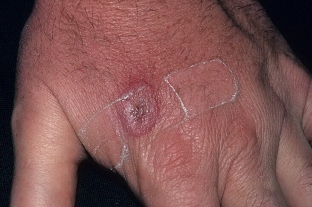The clinical manifestation of lymphoreticulosis (cat-scratch disease) may begin with rare and intermittent symptoms, which is characteristic of atypical forms of lymphoreticulosis.
Fever – a non-permanent symptom, occurs in 1 case out of 1200, atypical forms of CCC occur in 5-10% of cases and are often due to specific routes of entry of the pathogen. In addition to fever, lymphoreticulosis can manifest itself with other symptoms that are a manifestation of atypical forms of cat scratch disease.
Cases of manifestation of atypical forms of lymphoreticulosis
There have been isolated cases of complications of lymphoreticulosis with the development of neurological deficit in the form of cognitive impairment, as well as deaths. What isolated skin lesions can be with lymphoreticulosis, read on estet-portal.com. Complications such as myelitis, sciatica, compression neuropathy, cerebellar ataxia have also been reported.
Isolated skin involvement in CCC occurs in 5% of cases and is usually manifested by non-specific skin rashes, erythema nodosum, leukocytoclastic vasculitis (allergic or necrotizing).
Vasculitis is characterized by purpura that rises above the level of the skin (palpable purpura). The most common leukocytoclastic vasculitis affects the extremities.
Immunocompromised individuals, such as patients with cancer, HIV/AIDS, can develop dangerous conditions after organ transplantation. Read our previous article.
about the routes of infection and the classical clinical picture of lymphoreticulosis.Complications of lymphreticulosis in immunocompromised individuals:
- bacillary angiomatosis;
- toxic purpura;
- persistent or recurrent fever with bacteremia.
Bacillary angiomatosis as a manifestation of lymphoreticulosis
Bacillary angiomatosis – an angioproliferative disease with a primary lesion of the skin, but other organs may also be involved in the process. Such angiomatosis can develop as a manifestation of lymphoreticulosis and is characterized by the formation of single or multiple painless brownish papules, randomly localized in various parts of the body.
They rise above the surface of the skin and reach the size of the lymph nodes. Vascular formations are covered on top with thinned epithelium; if the tops are damaged, they bleed profusely. If antibiotic therapy is not started in time, the disease progresses, dissemination develops.

Drugs and treatments for lymphoreticulosis
As mentioned above, lymphoreticulosis is benign in nature and in most cases only symptomatic therapy is needed. Hospitalization of patients with CCC is indicated only in severe forms of the disease, the presence of immunodeficiency, in severe atypical forms of infection.
Analgesics are prescribed to relieve local discomfort, pain in the area of primary affect.
The use of antibiotics for lymphoreticulosis is indicated only in some cases:
- typical course in immunocompromised individuals;
- severe form of atypical course.
- henselae is sensitive to most antibiotics in vitro, but many of them are not effective enough in vivo.
Antibiotic therapy is not indicated for patients with mild to moderate CCC. Antibiotic therapy is recommended for all immunocompromised patients with CCC. Patients with generalized lymphadenopathy and severe intoxication are recommended representatives of a new generation of macrolides, in particular azithromycin.
In case of suppuration of the lymph node, it is necessary to perform a puncture with aspiration of purulent masses, and not an incision or drainage, as a result of which there may be a threat of infection.
Patients need to be explained that in the absence of changes in lymphadenopathy, after 2-4 months they must come for an examination to determine further treatment tactics.
If the general condition of the patient worsens due to lymphoreticulosis, or if the lymph nodes suppurate, it is necessary to start specific therapy or resume it, if any.
Outcome and prognosis of cat-scratch disease
The prognosis of lymphoreticulosis is favorable, spontaneous recovery usually occurs. In the typical course of infection from a cat, complications are rare.
Severe encephalitis and other disseminated forms of infection can lead to complications that may take a long time to resolve.
Due to the formation of persistent long-term immunity after B. henselae infection, recurrence is extremely rare.
In case of persistent symptoms of the disease that are difficult to treat, and with lymphadenopathy that does not resolve for a long time, lymphoma should be excluded along with other infectious pathologies in the diagnosis of lymphoreticulosis.







Add a comment